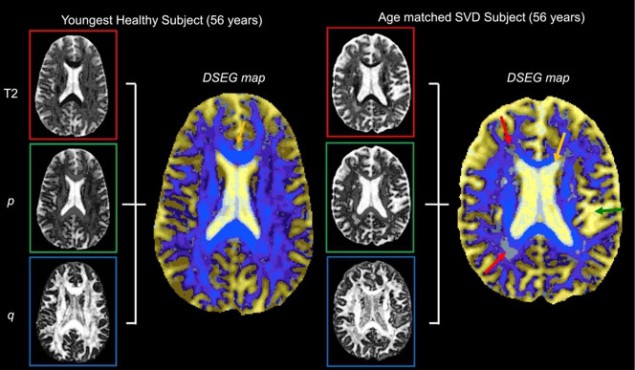
Researchers from multiple groups in the UK, headed up at St George’s University of London, have developed a single score MR imaging methodology for correlating cerebral small vessel disease (SVD) damage to cognitive decline (NeuroImage: Clinical 16 330).
The developed methodology utilizes a diffusion tensor image segmentation (DSEG) technique, combining several MRI-detectable SVD markers to produce a sensitive singular score for disease severity and brain damage. This enables monitoring of alterations in brain microstructure over time via a single angular measure – DSEG θ.

Diffusion tensor imaging is an MRI based technique that has been increasingly utilized for neuroimaging, due to its ability to image brain tissue damage. It uses the diffusion of water molecules in the brain to generate contrast and noninvasively image volumes within the brain. This technique may enable earlier and more efficient diagnosis of SVD, with better monitoring of disease progression in affected patients. This disease alters the microvasculature of the brain, resulting in a reduced cerebral blood flow to brain tissue. The reduction in cerebral blood flow causes the cognitive decline that is commonplace in SVD.
The use of DSEG markers allowed the study authors to accurately monitor changes in brain structure that correlated with cognitive testing in 98 SVD patients (aged 43–89) over a three-year period. DSEG measurements have been made previously to monitor tumour growth, but this is the first time that the methodology has been used to monitor sensitive and gradual changes in brain matter. Common imaging techniques for diagnosing and monitoring SVD only utilize a single marker, which does not always correlate strongly with disease progression and cognitive decline. The DSEG technique acquires scores by comparing SVD patients’ brain scans with those of age-matched healthy controls. This process accurately depicts microstructure changes within the brain.
The DSEG technique enables imaging of grey matter, white matter, cerebrospinal fluid and white matter hypersensitivities, which when combined to create a DSEG θ angular score can quantify brain damage effectively. The authors note that a limitation of this study is the lack of consideration for the spatial location of SVD related pathology.
Future studies could delve into the relationship between the spatial configuration of brain damage caused by SVD and the progression of cognitive decline. This imaging technique and implementation of a singular score denoting structural brain changes could be used for a range of neurodegenerative diseases – such as vascular dementia and Alzheimer’s disease – with great promise for advancing knowledge in this research area.



